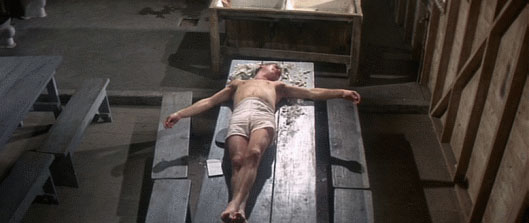Unearth the deeper layers of ‘Cool Hand Luke’ as we explore its Christian allegorical elements. Journey with Luke and Dragline, drawing connections to iconic biblical figures, and delve into the profound motifs that elevate this classic film beyond a tale of mere defiance.
“Cool Hand Luke,” the classic 1967 film directed by Stuart Rosenberg, starring Paul Newman as the titular character, is frequently interpreted as an exploration of nonconformity, rebellion, and the human spirit. While it is predominantly about a man’s defiance against an oppressive system, when examined more closely, the film also reveals numerous Christian allegorical elements. Specifically, there are striking similarities between the journey of Luke and that of Jesus Christ, as well as between Luke’s friend Dragline and the biblical Saul, who later becomes St. Paul.

Luke as a Christ-like Figure
Throughout the film, Luke exhibits characteristics and experiences events that are reminiscent of the life of Jesus. To begin with, both Jesus and Luke are seen as revolutionary figures challenging established systems. While Jesus questioned the religious and political systems of His time, Luke confronts the oppressive regime of the chain gang. Their defiant stances make them heroic but also place them in direct conflict with authority figures.
The symbols and gestures that align Luke with Jesus are not subtle. In one of the film’s most iconic scenes, Luke eats fifty hard-boiled eggs on a bet. After the ordeal, he is depicted lying on a table, arms outstretched, mimicking the pose of Christ on the cross, emphasizing the sacrifice and suffering he endures. This scene also suggests Luke’s resurrection-like ability to overcome seemingly insurmountable challenges, much like Jesus overcoming death.
Another significant parallel is seen in Luke’s relationship with God. Throughout the film, he grapples with his faith, often questioning God and seeking answers. In a powerful scene during a storm, Luke shouts at God, expressing his anger and frustration, which mirrors Jesus’ cry on the cross, “My God, My God, why hast Thou forsaken Me?”

Dragline as Saul/St. Paul
Dragline, initially an adversary to Luke, gradually comes to admire him and becomes his most ardent follower, much like the transformation of Saul to St. Paul. Saul, a once fierce persecutor of Christians, experiences a divine revelation and transforms into St. Paul, a significant apostle of Christ. Similarly, Dragline’s transformation from skeptic to believer signifies the power of Luke’s spirit and the compelling nature of his character.
After Luke’s final capture, Dragline, filled with grief and admiration, perpetuates the legend of Luke, sharing his stories and making him a larger-than-life figure. This act is reminiscent of St. Paul’s efforts in spreading the teachings of Jesus after His crucifixion, ensuring that the message lives on.

Other examples of Christian Allegory in Cool Hand Luke
Here are some other pieces of evidence and scholarly observations that reinforce this interpretation:
- Water Imagery: Just as water holds significant biblical importance (baptisms, walking on water, turning water into wine), water is a recurring motif in “Cool Hand Luke”. Luke is often shown washing, particularly in moments of reflection or transformation, symbolizing cleansing and rebirth.
- Miracles and Disciples: Like Jesus, Luke performs “miracles” that astonish those around him, such as the aforementioned egg-eating scene. These acts not only defy the norms of the prison camp but inspire and attract followers, making him a spiritual leader among the prisoners.
- The Judas Figure: There are betrayals in the film, most notably when one of the inmates turns on Luke, leading to his recapture. This act can be likened to Judas Iscariot’s betrayal of Jesus.
- Dialogue References: The script itself has biblical references. For instance, after one of Luke’s escape attempts, the Captain famously says, “What we’ve got here is failure to communicate.” This line resonates with the idea of prophetic messages being misunderstood or ignored, a theme evident in the New Testament.
- Sacrifice for Others: Luke’s sacrifices are not just for himself. His acts of rebellion, like destroying parking meters or even his multiple escape attempts, are as much about challenging the system for the benefit of others as they are about his personal freedom. This selflessness mirrors Jesus’s sacrifices for humanity.
- Scholarly Observations: Critics and scholars have long identified Christian allegory in “Cool Hand Luke”. For instance, the book “Race and Religion in American Film: Salvation and Cinema” by R. Gregory Black mentions the depiction of Luke as a Christ-like figure who challenges religious orthodoxy.
- The Garden Scene: In one particular scene, Luke is seen lying in a bunk, reminiscent of Jesus’s agony in the Garden of Gethsemane, a place of intense reflection and grappling with destiny.
Considering these points, it’s clear that “Cool Hand Luke” offers a wealth of material that can be interpreted through a Christian allegorical lens. The film’s enduring appeal lies in its ability to seamlessly blend this allegory with a tale of personal defiance and resilience.

Conclusion
“Cool Hand Luke” operates on multiple levels, weaving a narrative that touches on themes of individualism, rebellion, and resilience. However, the Christian allegorical elements provide an added depth to the story, drawing powerful parallels between the characters and biblical figures. Through Luke and Dragline, the film subtly reflects the enduring nature of faith, the transformative power of belief, and the eternal struggle of man against oppressive forces, making it a timeless cinematic masterpiece.